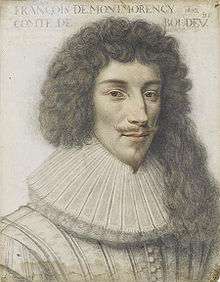François de Montmorency-Bouteville
François de Montmorency-Bouteville (1600 – 22 June 1627) was the second son of Louis de Montmorency, Comte de Bouteville, Vice-Admiral of France under Henri IV. In 1612 he became Prior of Plessis-Grimoult in name, and in person in 1616. He remained prior until 1618 when he stepped down in favor of his brother Louis.[1] François succeeded his brother Henri in 1616 and became Duke of Luxembourg and Governor of Senlis. He served with distinction at the sieges of Saint-Jean-d'Angély, Montauban, Royan and Montpellier.

After fighting a duel against the Comte de Pontgibaud, he killed the Marquis de Portes in 1625.[2] Dueling had long been forbidden, but the penalty of death was rarely enforced. Cardinal Richelieu, who believed the severity of the penalty contributed to its lack of enforcement, argued for its liberalization. An edict of February 1626 restricted the death penalty to duels in which one of the participants died, or the seconds also dueled. It was registered by parlement on 24 March.[3] Montmorency-Bouteville dueled and killed Jacques de Matignon, Comte de Thorigny, on 25 March.[4] He injured the Baron de la Frette in 1627,[5] then fled to Brussels to escape the wrath of Louis XIII. Eventually Louis XIII let it be known that Montmorency-Bouteville could return to France, but not to Paris or the court.[3]
François d'Harcourt Beuvron, a relative of Thorigny, was determined to avenge Thorigny's death. At the insistence of Louis XIII, a dinner of reconciliation was arranged in Brussels, but failed, and afterward Beuvron issued a challenge. On 12 May 1627 at the Place Royale in Paris, Montmorency-Bouteville dueled Beuvron without fatality, but Montmorency-Bouteville's second, François de Rosmadec, Comte de Chappelles, dueled and killed Beuvron's second, the Marquis de Bussi d'Amboise. While Beuvron took refuge in England, Montmorency-Bouteville and Rosmadec, despite their nobility, were beheaded at the Place de Grève in Paris on 22 June 1627.[6]
His posthumous son, François-Henri, became a Marshal of France; his daughter Élisabeth-Angélique was married in turn to Gaspard IV de Coligny (son of Gaspard III) and Christian Ludwig I zu Mecklenburg (son of Adolf Friedrich I).
Notes
- Alix, Frederic (1911). Les abbés du prieuré Saint-Etienne du Plessis-Grimoult, ordre de Saint-Augustin au diocèse de Bayeux [The Abbots of St. Stephen's Priory in Le Plessis-Grimoult, Ordre of St. Augustin in the diocese of Bayeux] (in French). Revue d'histoire de l'Église de France. pp. 728–733.
- Clémencet 1818, p. 63.
- Levi 2000, pp. 104–105
- Anselme 1712, p. 657 (Jacques de Matignon, son of Charles de Matignon, Comte de Thorigny ).
- Salabéry 1834, p. 546; Edwards 1893, p. 349.
- Clémencet 1818, p. 63; Levi 2000, p. 106.
References
- Anselme de Sainte-Marie, Augustin (1712). "Charles, Sire de Matignon, Comte de Thorigny", vol. 1, p. 657. Histoire genealogique et chronologique de la maison royale de France. Paris: Charles Osmont.
- Clémencet, Charles (1818). L'art de vérifier les dates des faits historiques, des chartes, des chroniques et autres anciens monuments, depuis la naissance de Notre-Seigneur. vol. 12, page 63. Paris.
- Edwards, H. Sutherland (1893). Old and New Paris: Its History, Its People, and Its Places, "Chapter 32: Paris Duels", vol. 1, pp. 345–354. London: Cassell.
- Le Bas, Philippe, editor (1841). "Bouteville (François, comte de)", vol. 3, pp. 291–293, in France dictionnaire encyclopedique. Paris: Didot.
- Levi, Anthony (2000). Cardinal Richelieu and the Making of France. New York: Carroll & Graf. ISBN 9780786707782. London: Constable. ISBN 9780094801905.
- Mackay, Charles (1852). Extraordinary Popular Delusions and the Madness of Crowds, vol. 1, page 281.
- Salabéry, Y. (1834). "Bouteville (François, comte de)", vol. 5, pp. 346–347, in Biographie universelle, ancienne et moderne. Paris: Desplaces, Michaud.